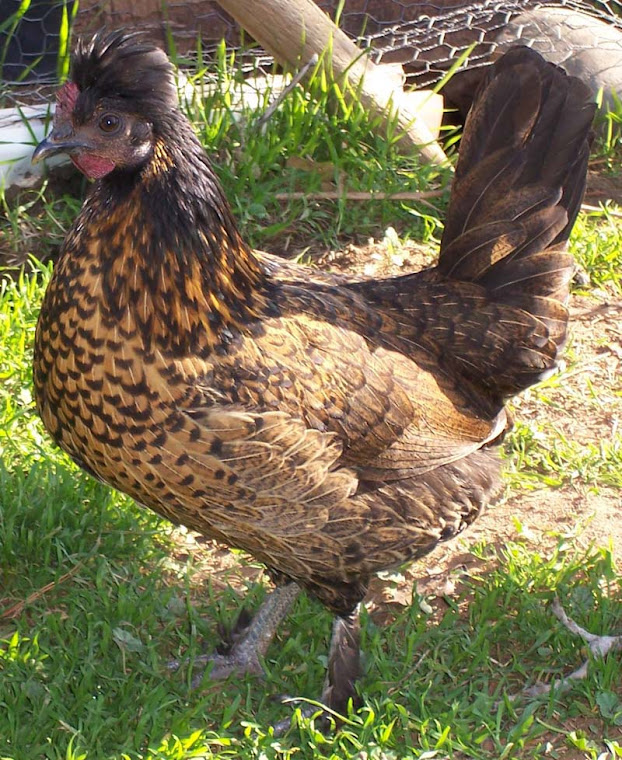Well, everyone has seen brown eggs and white eggs in the supermarket. But there's a third color category that has never has caught on in the market, and I have yet to figure out why. It's the blue- or green-shelled egg. I have more fun with these eggs. When somebody asks if we have eggs available, and I pop open a carton, what's the first thing they notice? Not the cute little brown bantam eggs, not the glossy white Polish eggs, but "Oh my gosh, what laid those green ones?!"
Well, these girls do.
 |
| Charger |
Meet Charger, Colleen, Bluebelle, Silver, Gladys, and Cadge. These girls are all Easter Eggers, which is a slightly more polite term than "mutts that just happen to lay eggs that are blue, green, or olive." All but Silver are hatchery chicks; Silver is a second-generation bird, the result of our brief fling at keeping an Easter Egger rooster in with the main laying flock. Sadly, Brutus did not get along well with boss rooster Elwood, so he went to a friend.
 |
| Colleen |
But then, I am thoroughly biased. I keep these birds as pets; the eggs are just a pleasant side benefit. My very first hen was a barred Easter Egger named Nova. She looked exactly like a production Barred Rock, except for her green legs and the lime-green eggs she laid. At the time I had no idea that she was an Easter Egger, so that first green egg came as a considerable shock. For years after that we would pester Mom to fix "green eggs and ham!" for breakfast. The novelty never really wore off.
 |
| Bluebelle |
 |
| Silver |
The blue egg gene pops up everywhere it can, since it's what is termed a dominant gene (meaning that even if a bird has only one copy of the gene, it will still manifest). Like with white eggs, a blue egg's shell carries that pigment throughout its thickness. By comparison, a brown egg only has brown pigment applied to its outermost layers. When the blue egg gene is combined with brown egg genes, the resulting shell colors range from green to olive. So a green egg is basically a blue shell, overpainted with a little brown; an olive egg is one overpainted with a lot of brown.
 |
| Gladys |
Despite its popularity, the Easter Egger is not considered a proper breed. EEs are something of an offshoot of a couple of genuine, recognized breeds: the Araucana and the Ameraucana. Araucanas hail from South America and are tailless, have long tufts of feathers in front of their ears (not to be confused with the "muffs and beard" that Colleen and Bluebelle are sporting above), and lay a blue egg. Ameraucanas carry some of the same genes, but not all. They have muffs and a beard--they must, in order to qualify for breed standard--and they generally lay either a blue or a green egg. But the EE is the result of hybridizing Ameraucanas with other birds, and there isn't much of a standard. An EE often does have muffs and beard, but not always. She generally has green legs and a pea comb, but not every time. Their colors don't breed true: if you breed two brown EEs, you might end up with some real surprises in the chicks, such as white or black with brown. And the eggs an EE hen lays could be blue, green, olive, brown, or pink. It's a lot of fun picking up the eggs at night! Besides, depending on what other shell-color genes went into the mix, your green eggs might be flecked or speckled with brown, or finely stippled with white. After seeing a carton full of color, plain old white eggs seem very boring.
 |
| Cadge |
Anyway, if you are thinking about getting a few chickens for your backyard, I would heartily recommend some Easter Eggers, although you would be in equally good hands . . . err, claws . . . with Ameraucanas. Between the colors of the eggs and the birds themselves, their personalities, and the added plus of hybrid vigor--the unquestionable advantage to being a mutt--you'd be hard put to find a better "starter" bird. And if you get hooked for life on chickens . . . well, don't say I didn't warn you. :)




